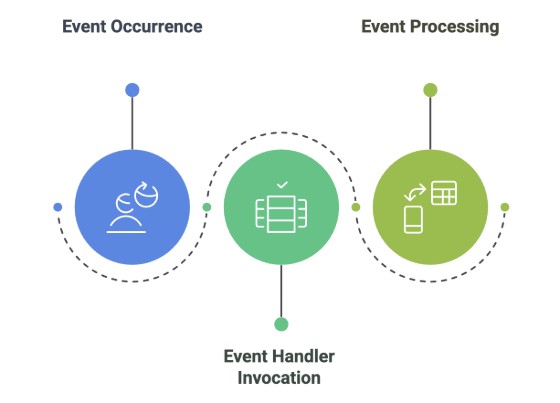Event-driven programming is a standard of software engineering design where the execution of the program is dictated by the occurrence of certain events. These events can originate from user inputs or communication with other software applications.

In event-driven programming, the program is responsive to a specific set of events, which are executed through event handlers (or listeners), which contain code that performs an action corresponding to the event. In contrast to traditional programming methods, the flow of a program is not executed in a sequential and linear order but rather allows for idle time until an event is executed. When an event occurs, the associated event handler is executed, which then processes the event and executes other events.
Key Components of Event-Driven Programming
- Events: Actions or occurrences that trigger a response from the system.
- Event loop: Sustained cycle that waits for events to occur and processes them when they do.
- Listeners/event handlers: Functions or methods that are executed when a specific event is detected.
- Message queues: Messages that are often placed in queues to be executed in a controlled order in more sophisticated systems.
How Event-Driven Programming Works
Let’s go through an example to illustrate how event-driven programming works. Consider a simple code sample in JavaScript that simulates an event where a user clicks a button.
const EventEmitter = require('events');
// Create an instance of EventEmitter
const eventEmitter = new EventEmitter();
// Define an event handler for a 'userClick' event
function onUserClick() {
console.log("User clicked the button!");
}
// Attach the event handler to the 'userClick' event
eventEmitter.on('userClick', onUserClick);
// Simulate a user click event after 3 seconds
setTimeout(() => {
console.log("Simulating user click...");
eventEmitter.emit('userClick'); // Trigger the event
}, 3000);In the above code:
- We first create an EventEmitter instance.
- Then, define an event handler function onUserClick(), which is triggered when the userClick event is emitted.
- Here, we simulate the user action by emitting the userClick event post to a 3s delay.
Output: The above code exhibits how an event is triggered (userClick) and handled asynchronously. It should get an output as below.
Simulating user click...
User clicked the button!Importance of Event-Driven Programming
Due to the excessive use of highly interactive applications, asynchronous processes, and real-time communication, event-driven programming can be nominated as a pivotal factor in building applications. This provides an interface for building software that is responsive to external inputs.
- Responsiveness: Allows programs to be responsive by authorizing them to wait for events without obstructing other operations.
- Scalability: Can manage a large number of concurrent users or events without requiring a massive amount of resources.
- Asynchronous processing: Supports managing asynchronous tasks and allows multiple tasks to be processed at once.
- Decoupling of components: Focuses on different parts of an application to operate independently. This makes it easy to maintain and scale.
Event-Driven Programming Languages
The popularity of event-driven programming has increased rapidly among users in recent years since several reputed tools and frameworks have been developed to easily comply with event-driven systems.
These tools massively assist in managing the complexity of asynchronous programming, ensuring that events are processed effectively and efficiently.
- Node.js: a JavaScript runtime built on Chrome’s V8 engine that uses event-driven, non-blocking I/O models; has a reputation for building scalable network applications.
- RxJS (reactive extensions for JavaScript): a powerful library for reactive programming that uses observables; best suited for asynchronous JavaScript event handling.
- EventBus: a messaging tool used in server-driven and event-driven architecture systems for inter-component system communication.
- Apache Kafka: a popular tool for building real-time data pipelines and streaming applications as a distributed event streaming platform.
Advantages of Event-Driven Programming
- Ensures that applications react immediately to user inputs or system events, improving user experience and efficiency.
- Promotes a modular structure where event handlers are separated, making code easier to maintain, debug, and extend.
- Can scale easily by adding new event handlers without restructuring the entire codebase.
- Ideal for real-time systems that require immediate responses, such as financial trading applications or security monitoring tools.
- Allows tasks to run asynchronously, improving performance and resource utilization.
Challenges of Event-Driven Programming
- In large, event-driven applications, the flow of execution can be difficult to trace.
- The asynchronous nature of the program makes it harder to predict when events will occur.
- Callback functions are often used in event-driven systems to handle asynchronous tasks. When many callbacks are nested within one another, it can lead to “callback hells.”
- Though event-driven systems can be more efficient, they can also be resource-intensive in certain scenarios.
Conclusion
Event-driven programming has evolved into a powerful and widely used approach in software development. It enables the creation of highly interactive, real-time, and scalable systems, making it especially valuable in areas like GUI development and real-time applications.
While event-driven programming offers benefits like flexibility and improved user experience, it also comes with challenges such as complex debugging, testing difficulties, and callback hell.
However, modern tools and frameworks have made event-driven systems easier to manage. Its compatibility with Agile methodologies further solidifies its role as a key part of modern software development.
